#7: Prambulation
Ed Jefferson is attempting to visit every Mews in Greater London. This week: cursed swimming pools, lost railway lines, and shooting fireworks out of your arse, but first…
As may or may not be apparent, I enjoy stories of people who do odd, pointless things for hard to discern reasons, so I’ve long been fascinated by Harry Bensley: a mysterious figure who spent much of 1908 pushing a pram around England’s largest towns and cities, wearing the iron helmet from a suit of armour. Was it a pilgrimage? A viral marketing campaign? Edwardian psychogeography?
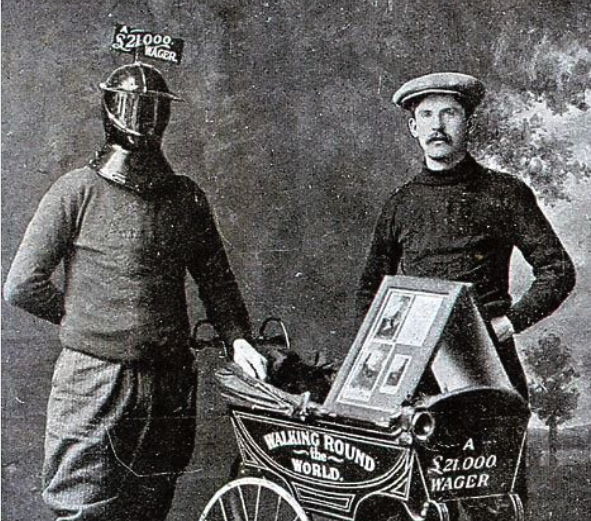
According to the postcards and pamphlets he sold as he went, this was the man’s story: one night at the National Sporting Club in Covent Garden, J.P. Morgan (that one) and the Earl of Lonsdale started arguing about whether someone could circumnavigate the globe, without being identified, on foot (presumably you were allowed to get on a boat for the watery bits). Lonsdale said yes; Morgan said no.
Enter, somehow, roguish investor Harry Bensley, who agreed to personally put the matter to the test. Lonsdale and Morgan wagered £21,000 on it – almost £2 million in today’s money. The challenge’s principal rule was that, to disguise Bensley’s identity, he would wear an iron mask from a suit of armour. Another condition specified 169 cities and towns in England and Wales, and 125 others across the world, that he’d visit in order. He’d also have to push a baby’s pram (sans baby) the entire time, finance the journey by selling promotional postcards, and, er, find a wife.
One version of the legend states he almost made it, having walked 30,000 miles over six years, before the bet was called off because of a rather inconvenient, and not that great actually, war that kicked off in 1914. After some time in the army, Bensley returned home to find out that Russia, where he’d invested heavily, was having a slight revolution, and he was now broke.
Did any of this actually happen? All anyone can say for sure is that, for several months in 1908, for whatever reason, Harry Bensley took an extremely circuitous walk around southern1 England and Wales, wearing his helmet and pushing his pram. Researcher Tim Kirby has ‘tracked’ the journey through contemporaneous press reports:
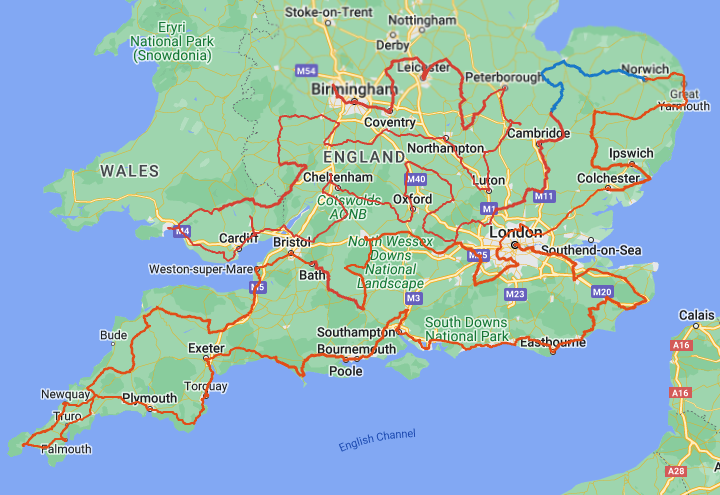
According to Kirby’s theorised route, the furthest Bensley ever made it from London was Penzance (according to the report in The Cornishman, he declined to go as far as Lands End "as there was no stipulation to that effect" - lazy).
En route he apparently sold a postcard to the king, received 200 proposals (some reports mention that the woman he married would herself receive a £500 ‘prize’, which may explain this), and ended up in court for selling stuff without a license, where he somehow managed to get away with keeping his helmet end. By the autumn, though, the journey had come to a premature end, in Wolverhampton. As usual.
So what’s the truth behind all this? According to Ken McNaughton, Bensley’s great-grandson2, the family legend (as apparently told by Bensley to his illegitimate son) was that the walk was done as a forfeit, in order to avoid a crippling loss he’d incurred while gambling at his club. But no-one has ever actually been able to prove that J. P. Morgan or the Earl of Lonsdale had anything to do with it.
Was it just a good story to help sell some postcards? Well, yes, maybe. Bensley himself wrote an article in December 1908, confessing that the whole thing had been a money-making publicity stunt he’d cooked up while in jail, which had rather backfired when it turned out wearing a 4 lb helmet all day for months on end wasn’t much fun. He reported that the trek had covered 2,400 miles, and that he and his entourage – including a man acting as an “observer” sent to ensure he stuck to the rules of the bet – had been solely supported through sales of postcards and other souvenirs. That said, he’s at such pains to impress this on the reader, you do wonder if he’s protesting a bit too much: could the rewards possibly have been worth going to such convoluted ends? On the other hand, when has that stopped anyone else?
It seems unlikely that, nearly 110 years after the scheme was concocted, we’ll get any clearer answer as to why it was concocted. Maybe we just have to simply enjoy that it was concocted, and leave it at that.
Or maybe sometimes a guy just needs to put on an iron helmet, load up his pram and start heading for Wolverhampton, you know? The future case for Ed Jefferson’s defence rests, your honour.
(Much of the above reworked from an article that originally appeared on the late lamented CityMetric website.)
MEWSES VISITED THIS WEEK
#61 Albert Mews, Haringey, N4

What I hadn’t appreciated when I started doing this is how much time I have to spend trying to inconspicuously lurk while waiting for smokers to finish cigarettes so I can photograph the mews without them in the picture.
Albert Mews is home to an acupuncturist and the London office of website selling cashmere - gentrification in action - but also improbably about 50 other companies, which either means they’re just registering the address of an accountancy firm or they’re run by mice.
It’s just off the Stroud Green Road, which is one of those slightly weird bits of naming because it invites the question ‘Where actually is the Green bit of Stroud Green?’ to which the answer is ‘underneath Stroud Green Road’.
#62 Bridgemount Mews, Haringey, N4
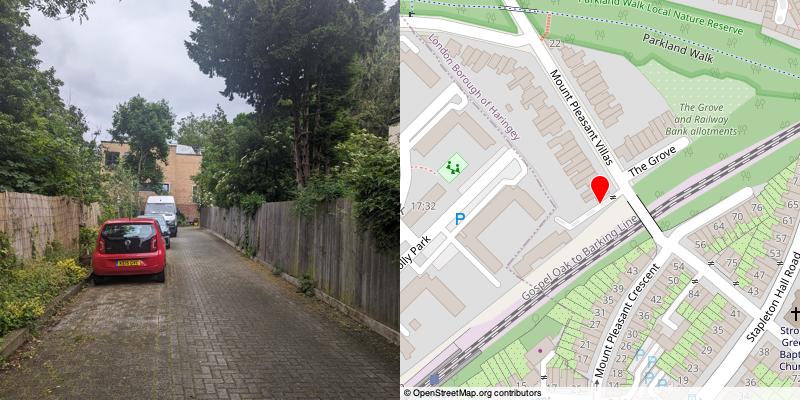
Newish development next to the bit of the Overground that is to become the Suffragette Line. I wonder if anyone checked whether this was one of the bits of railway they attempted to blow up, could have some great “discourse” about that I bet.
The entrance to Bridgemount Mews is the proposed site of one of the poles that would carry a wire marking the boundary of an Eruv for the local Jewish community. An Eruv is an area enclosed by a physical boundary, within which (some interpretations of) Jewish law activities that might otherwise not be allowed outside the home on the Sabbath become permissible - including carrying medicine and nappies, and using a wheelchair3. It can incorporate existing physical boundaries, but often involves running lengths of wire to bridge gaps - over roads, entrances to parks, and so on.
The construction of Eruvs can be controversial, with various kinds of opposition from both Jews and non-Jews, but the physical reality is that in practice it is the sort of the thing you are unlikely to notice exists unless someone points it out - there are over a dozen of them in London already and I’ve walked through many of them without ever noticing.
One resident of Bridgemount Mews had a very specific objection, however - that, logically, the pole to be placed outside their house would occasionally need maintenance work, and that this meant people would have to climb up the pole, from where they would be able to see into the resident’s windows. Just put some pants on, mate.
#63 Ossian Mews, Haringey, N4
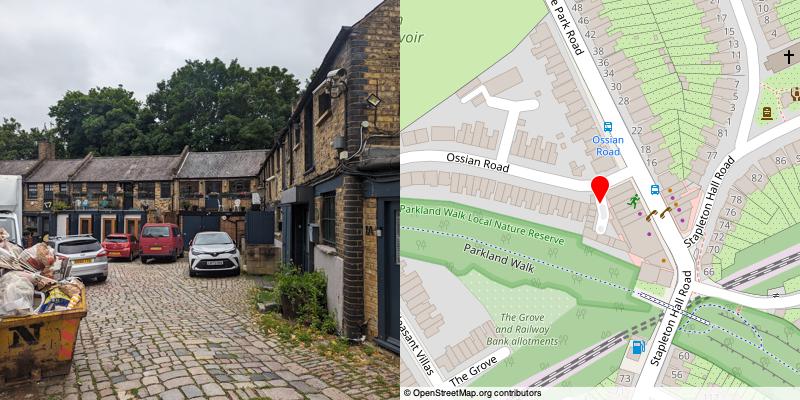
Something about this name caused it to bounce around the inside of my skull for a bit until it knocked something loose that suggested I had once had a conversation with a man in a pub who had mentioned that he had a recording studio based here. After further concentrated remembering, I finally pulled that it had been the launch party for Bluebird, an excellently eerie audio drama about strange echoes of the Cold War turning up in rural England, put together by Minimum Labyrinth (whose site provides links to places where I believe you can now listen to it for free) - which had been recorded here.
Just outside the Mews someone has attached a small wooden notice board to a tree. It contains a slightly crumpled poem about why leaving plastic bottles underneath the tree is bad (“though we are all complicit when you think about it”, apparently).
#64 Parkgate Mews, Haringey, N6
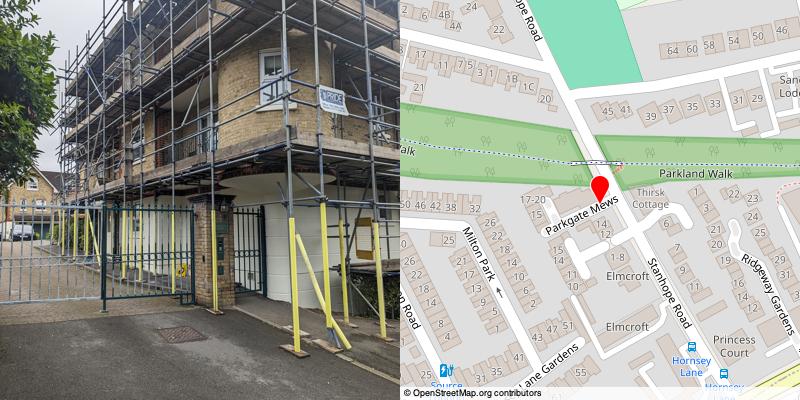
Some failed etymological logic here, as there is neither a park nor a gate here. Presumably a flawed reference to the Parkland Walk, an old railway line which used to run between Finsbury Park and Alexandra Palace and was to become part of a mooted expansion of the Northern Line until the outbreak of World War 2 changed priorities somewhat. By the 1950s passengers had voted with their feet and the line was closed, and since 1984 it’s been a nature reserve and convenient route to walk up to Highgate. May or may not have inspired a Stephen King short story called ‘Crouch End’ (probably not, but he once stayed with a friend nearby); I can certainly vouch that it is fairly terrifying to walk along it at night which is a mistake I only made once when I lived round here.
#65 Maybury Mews, Haringey, N6

1980s housing development (“stagey” says Pevsner’s Guide, dryly) of which the most interesting feature is a slightly dilapidated looking communal swimming pool in the basement decorated with cod-Egyptian hieroglyphics that don’t NOT make it feel extremely cursed.4
#66 Oldfield Mews, Haringey, N6
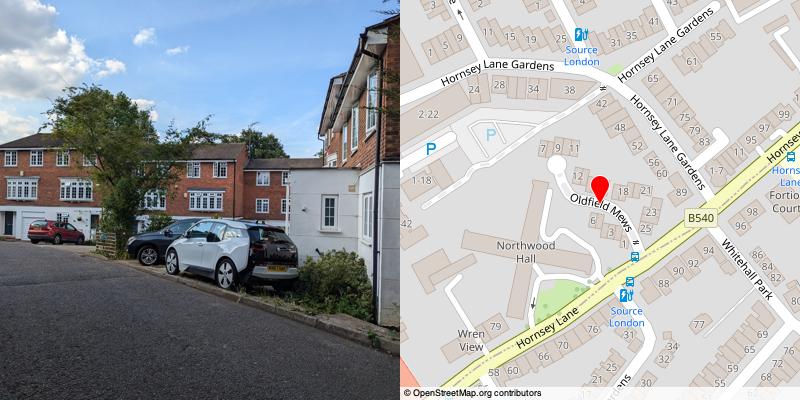
This was once a row of houses which 1930s newspaper ads for maids and "RARE ANTIQUE UPRIGHT WALNUT piano. What offers?" suggest may been at least reasonably well-to-do. Something must have gone wrong as by the 1960s it was being advertised as a potential building site, though it took until 1980 for this gated estate to open. Despite the the institutional-looking layout, Northwood Hall next door is actually a rather swanky Art Deco housing block, although sadly it at some point lost a roof garden which must have offered some fairly spectacular views.
#67 Wembury Mews, Haringey, N6

More unexpected Mews modernism (see Atherton Mews in Newham) in the various redevelopments along here, which you suspect they wouldn’t have gotten away in the surrounding streets of Highgate, although only this house is particularly interesting, achieving a sort of TARDISy bigger on the inside effect.
#68 Parkwood Mews, Haringey, N6

Because it’s the place near the wood where you can park, presumably - some garages, some garages, some garages that got knocked down and had houses built on them (with garages). Wonder if the residents of this and Parkgate Mews (above) get a lot of each other’s mail?
#69 Hillfield Park Mews, Haringey, N10
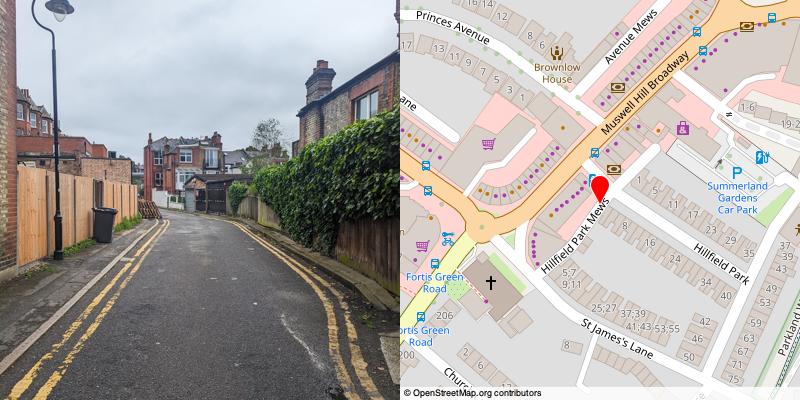
One of the houses on the corner of the Mews and Hillfield Park has a blue plaque stating that musician/eccentric Vivian Stanshall lived “down our street” from 1990 to 1995 - perhaps the specific building declined the honour because the reason he stopped living there was, unfortunately, ‘death by electrical fire’. He will return to the Mews Letter at a later date.
The Mews itself has tenuous theatrical links - in 1987, Scott Cherry an actor who also wrote for The Bill, lived here and wrote to ‘The Stage’ complaining that the government support scheme for unemployed people with mortgages was unfair to actors (the monkey’s paw curled on this one, as the equivalent nowadays is more or less a piece of paper with “LOL” written on it).
Perhaps dire financial straits were behind another thespian resident’s side hustle - Vanda Lyman, an actress and circus clown, was arrested for importing cannabis. I can’t find much else about her, but it appears she was married to performer Chris Lyman, famous for concluding his act by taking all his clothes off and shooting a firework out of his arse. No evidence he ever did this on the Mews, but then again there’s no evidence he didn’t do it.
#70 Avenue Mews, Haringey, N10

This was at some point actually a proper mews with actual horses, and survives as a working mews of a sort, with a joinery, a microbrewery (Muswell Hillbilly) and a couple of vintage shops - I think this is the first Mews I’ve covered that has its own Instagram account, although presumably it doesn’t actually run it personally. I need to remember to keep track of all the mewses that have pubs/bars/taprooms on them and devise a mews-based pub crawl.
Total mewses visited: 70/2380
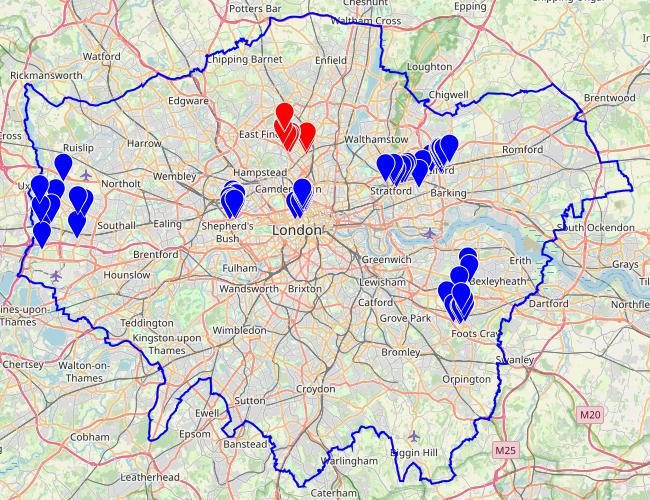
Relatively.
There’s no evidence that he is beyond family legend, but it is an awfully specific bit of family legend.
Though the ins and outs of what is and isn’t permissible under different circumstances are not universally agreed upon.
Add a comment: